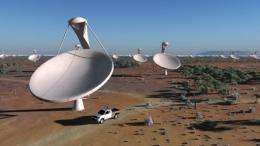SKA super telescope to be built in Australia, South Africa (Update 2)

A long-running joust to host a radio telescope that would give mankind its farthest peek into the Universe ended on Friday with a Solomon-like judgement to split the site between Australia and South Africa.
"We have decided on a dual site approach," said John Womersley, chairman of the board of the Square Kilometre Array (SKA) project, at a press conference in the Netherlands.
He was speaking at Amsterdam's Schiphol Airport following a meeting of the SKA organisation's members.
The two southern-hemisphere countries had been fighting fiercely to host the innovation, billed as a revolutionary giant that will be 50 times more powerful than present radio telescopes. New Zealand is included in Australia's bid.
Conceived more than two decades ago, the Square Kilometre Array aims at bringing together unprecedented size and new technology.
It would use a forest of antennae, spread out over remote terrain, to pick up radio signals from cosmic phenomena that cannot be detected by optical telescopes.
Stars that flare into life or explode at their death, black holes, mysterious "dark energy," and relic traces of ancient events that occurred in the dawn of the Universe 14 billion years ago, are among its targets.
"Today we are a stage closer to achieving our goal of building the SKA," said Womersley in a press release.
"This hugely important step for the project allows us to progress the design and prepare for the construction phase of the telescope.
"The SKA will transform our view of the Universe; with it, we will see back to the moments after the Big Bang and discover previously unexplored parts of the cosmos."
South Africa swallowed its disappointment, saying a split was "unexpected".
"We had hoped the unambiguous recommendation (to build the telescope in one location) ... would be accepted as the most sound scientific outcome; however we accept the compromise in the interest of progress," Minister of Science and Technology Naledi Pandor said.
For its part Australia was jubilant.
"This is an outstanding result for the Australia-New Zealand bid after many years of preparation and an intensive international process," said Science and Technology Minister Chris Evans.
At the press conference, Womersley said the compromise decision was taken after a recent meeting by a SKA working group, which he said "made the best use of both the significant investments these countries made into astronomy."
But a source told AFP the decision was made because the SKA organisation wanted to "maintain our broad support base", hinting that the there was concern that the loser of the two contenders might have pulled support.
The scheme entails linking 3,000 antennae, sited in groups along five spiral arms, progressively farther from a core array.
Together, this creates a collection area of one square kilometre (0.4 square miles), leading to a 50-fold gain on sensitivity compared to present radio telescopes.
The idea of the SKA was floated back in 1991, but since 2005 the project has been troubled by wrangles over the site and concerns over budget.
Australia's International Centre for Radio Astronomy (ICRAR) said the "aperture array" type of antenna intended for Western Australia were designed to pick up low-frequency radio waves, which would be useful to survey large portions of the sky quickly.
In southern Africa, the dish-type antennae would observe smaller sections of the sky in more detail. They would follow up on regions of interest discovered in the survey.
Despite these differing roles, there remain important blanks about how the two rival schemes will dovetail and whether there will be implications on timetable and cost, said analysts.
"The office of the SKA Organisation will now lead a detailed definition period to clarify the implementation," the SKA said. The assessment will take about six months.
Australia's core site is about 100 kilometres (60 miles) west of Meekathara in western Australia, with antennae distributed as far as New Zealand. South Africa's site in the arid Karoo region would be connected to dishes stretching across southern and eastern Africa and as far away as Ghana.
Headquartered in Manchester, England, the SKA is a partnership of 67 organisations in 20 countries. Eight countries are full members of the consortium, including Australia and South Africa.
According to plans that were made for a single-site project, the first phase of the scheme would be completed by 2019 and become operational in 2020.
The second and final phase would be completed in 2024.
"The target construction cost is 1,500 million euros," or $1.87 billion at today's exchange rates, SKA said on Friday.
This figure is unchanged from previous estimates, but sources at the SKA said there are likely to be additional costs from a dual-site format.
(c) 2012 AFP



















